#2015 Show Reviews
Note
You got to see Jenny Hval live?? Mad with jealousy
yes!! and i paid like $10, and it was in the small and kind of janky club//bar/performance space in the basement of the student center at my college!!
#i stole one of the posters they had advertising it and i think i still have it somewhere...........#tbh there were some really crazy music acts that came through there who i didn't realize the significance of until later#i remember MERZBOW performed in my freshman year and my roommate had signed on to review the show for the school newspaper#so i went with her and......................suffice to say we Did Not Get It#the other one which is even crazier is that i saw LUCY DACUS perform FOR FREE (before i even knew who she was!) in like 2015 or 2016#bc i think she was friends with a guy in my year or something#anyway this is just a few of them but there were a lot more (some who came while i was there but who i didn't actually see....)#voluptuarians#asks
2 notes
·
View notes
Text
utaformatix... save me..
utaformatix
save me utaformatix
#genuinely such a godsend that website#in the far off year of like. 2015 if you wanted to turn a vsqx into a ust and all you had was utau you had to fight for your life#but you can do anything now. any vpr. any vsq. any ust. any xml whatever. you can turn it into an svp or whatever your heart desires#IN SECONDS. AND THERES japanese lyrics conversion with romaji and kana and vice versa#so so awesome utaformatix if my best friend#im doing my playing on my computer with vocal synthesis instead of sleeping at 2am thing again and like#i decided to finally check out the new voicevox song pitch editing update#review: pitch editing rules. unfortunately it seems to have broken the pitch line display tho LOL#BUT not entirely. if you draw notes directly in the program its fine#i also tested out a musicxml file and it worked fine too#its JUST the ust importing is what im learning. theres an open issue on the github about the problem#it also only displays in pitch editing mode which im not sure is intentional or not. i think it is. im preferred it when it showed in both#modes personally like it was in the old update but thats okay either way. more important is the ust importing sitch#but i dont speak japanese so i dunno if i should mention something. id feel a little bad like hello. sorry im machine translating this#entire convo because i know exactly 1 kanji (hito.....looks like ^ but big...) but im doing the scientific method on your software at 2am#i'll figure out if and how to bring it up later. now i should sleep because i have a shift tomorrow which ive been ignoring <3
2 notes
·
View notes
Text
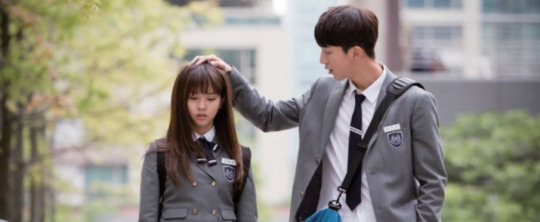
who are you? school 2015
I decided I should watch this after living through two things. 1- watching Weightlifting Fairy Kim Bok Joo and falling in love with Nam Joohyuk and 2-there was one clip I kept seeing that just made me intrigued.
I always question if I enjoy Kim Sohyun's acting but I think it's just because the characters she portrays (that I've watched) have made decisions I don't agree with (I'm sorry I will never get over Love Alarm). But with this one I think she was able to finally sway me.
I've seen people online be mad about the outcome of the lead couple, but not me, perhaps I am just biased.
Lastly, I hate to say this but I swear it's positive: it reminded me of 2013 Wattpad fan fiction plot but they were able to deliver.
Plot: 80
Acting: 80
Ending: 70
TOTAL: 77/100
recommend? yes
links:
explore tags | about the blog | recommend kdramas
#who are you school 2015#kdrama review#kdrama#korean drama#korean tv series#korean tv show#tv series#yes#70s#40#kim sohyun#nam joohyuk
5 notes
·
View notes
Text
Dragon Ball Z: Abridged Episode 15 Review
Originally posted on September 11th, 2015
A failed attempt at positive representation.

You remember how last week I defended Dragonball Z: Abridged use of sexism and sexist jokes as a method by which to deconstruct characters that otherwise would be perfect? Well I really wish that I could say the same thing about the way in which Operation: Dodoria Drop handles the titular character, Dodoria, and Team Four Star’s revelation that she is in fact a she, despite her very masculine appearance and deep guttural voice.
This revelation comes about in the middle of a fight between her and Vegeta, as Vegeta insults her for “crying like a woman,” after which she screams out “I AM A WOMAN!” Then we cut away, and once we return, she has finished explaining that the way her alien species looks means that she, a large masculine looking woman, is among the most beautiful and “fertile” women on her planet.
On its own, I would be all for this: it’s a clever subversion of the expectations of femininity that people assign to women, as well as a clever dig at the fluctuating (and often unreasonable) standards of beauty we hold women to. I don’t even have a problem with her dying not long after she “comes out” to Vegeta, because she was working for a villain in an adaptation of Dragonball Z; her demise was inevitable.
The issue comes with the comments Vegeta makes to her after finding out her gender. He responds as if she’s a disgusting creature, and proceeds to guarantee that he will repress the memory of her gender (probably implying a refusal to acknowledge her gender in the future).
On the one hand, it’s completely in character, both with who Vegeta is, and who Team Four Star has slightly altered him to be. But it feels far too much like hurtful “punching down” humor for me to see it in any other light. Trans women and butch women are frequently harassed in real life for their appearance, and trans women are also subject to hateful jokes that deride them for not being “real” women for many reasons, and I can’t help but see Vegeta’s remarks as anything but an extension of that hateful behavior.
But on the other hand, I don’t think that Team Four Star meant any harm at all in this. In fact, I think that their intentions went no further than to include a little representation for butch women, trans women, and/or gender nonconforming folks. The inclusion of the (again, completely in character) transphobic humor ended up muddying what could’ve been great, clever, and funny representation, but their heart seemed to be in the right place, and they deserve credit for that.
Rating: 3/5
If you like this review, please consider supporting me on Patreon.
Stray Observations
Dr. Briefs: “Where did you get that muffin?”
Goku: “Muffin button.”
Dr. Briefs: “But I never installed a muffin button.”
Goku: “Then where did I get this muffin?”
*crushes scouter*
Vegeta: “It’s broken.”
I want to see a whole montage of Goku training to “Cooking by the Book” (or better yet, to the remix with Lil Jon).
@kaiserneko (tagging you for the sole purpose of thanking you for boosting this review back in the day. meant a lot to me back then and still does today)
#dragon ball z abridged#dragon ball z#team four star#dbza#film criticism#dbza ep15#and here we are#the most popular review of DBZA that I ever posted#scott/kaiserneko saw this post and shared it with some comments that he saw the criticism as valid#and it spread from there#on the one hand here#i am not sure if i still feel the same way as i did in 2015#i was a young baby trans back then#and had a lot to learn and a lot of growing to do#but i feel sympathy for myself back then#because a clumsy joke from a show i loved ended up hurting me more than i expected or wanted#nowadays though? i think it's a little clumsy#but it does not hurt the same it did back then#because i see the good intention behind it#and care far more about that than it being handled somewhat imperfectly#i mean seriously#at least team four star tried to put butch/masculine women in its show!#what other show can you actually say that about?#not many that's for sure
9 notes
·
View notes
Text



#my post#mine#every time someone gets mad at the millennial food review lady or the starbies girl#bc they don't think people like that still exist#i want to show them this so badly#there are people on websites who have crystallized in amber since 2015#it's almost beautiful
1 note
·
View note
Text
Scream Queens (2015)
Scream Queens invokes the slasher genre of the 90 with a sorority twist that invokes "The Heathers". 3/5 stars for the fact that the Chanels might grate on more nerves than just mine. More in the link.
Rating: 3/5 Stars
Rotten Tomatoes Rating: 77% Critics, 75% Audience
Overview: A slasher series that follows a sorority as they try to survive a masked killer intent on picking them off. Who will be the final girls or will the killer prevail?
Best elements: The twists and inversions in the plot keep the story from falling flat by keeping you invested in who might die next, and who is doing the…

View On WordPress
#Horror#Horror TV#Scary Stories#Scream Queens#Scream Queens (2015)#Slasher films#TV reviews#TV Show Reviews#tv shows
1 note
·
View note
Text
I watched all of modern Doctor Who and these were my favorite episodes.
If you told me back in 2015 that I'd watch the entirety of modern Doctor Who, I'd probably think you're a liar. But, a cute girl wanted to watch Doctor Who with me, and how do you tell a cute girl “No?” Being that of the Superwholock trinity, Doctor Who the least upsetting of the three, I figured “Why not?” I mean, it's enjoyed by thousands and thousands of people, surely it has merit for existing, right?
And, it does! There are many great episodes that I really enjoyed (not to mention a lot of schlock I hated). I even enjoy some of the old serials and that 1996 movie is pretty fun (so very 90s). I can't claim to have seen all of Doctor Who, there is a lot of old stuff I'm probably never going to know even exists, not to mention all the spin offs and audio dramas, there's no way I can get through it all. But, I have seen the modern run, starting with Christopher Eccleston all the way to Ncuti Gatwa in Empire of Death.
Annnnd, anyone that knows me knows I love to rank and review episodic tv shows. So, with that said, here are my 15 favorite episodes of modern Doctor Who:
15 - Dalek (S01, E06)

It is probably unsurprising to any Doctor Who fan to see this episode on the list. The Eccleston era was my introduction to Doctor Who (as I'm sure it was for a lot of people) and this episode was my introduction to the famous villain, the Daleks. It's really a wild way to be introduced to the Daleks when you think about it, the Doctor and his companion Rose end up in an underground museum of alien artifacts out in Nevada and find the man that runs it has a Dalek in captivity. Upon learning of the Dalek's existence, the Doctor goes on a campaign to kill it with extreme prejudice until Rose yells at him about how he's being this horrendous person – which makes the doctor have a “Maybe I'm the baddie” moment and it resolves peacefully. Genuinely is really a good episode about moving on and realizing that we all have good and evil in us. A true standout of the early modern run of the show.
14 - The Impossible Planet & The Satan's Pit (S02, E08&E09)

There's a spectrum when it comes to Doctor Who, there are episodes that are gorgeous and smart and well thought out, then there are episodes that are just absolutely ridiculous. If Dalek explores the prejudice that can be enacted by those we see as “good,” then this duo of episodes is “what if the Christian devil was real and he was in space.” This is such an unbelievable hit of stupid bullshit, but it's delivered so very well. The first episode is loaded with mystery and adventure and unknown horror, while the second episode introduces the goofy concept in whole but still somehow grounds it enough that it still feels like a real plot with real stakes. It's the acting. The actors really sell this one to you. Space Satan is not what I expected when getting into this show but hey, it works and I like it.
13 - Blink (S03, E10)

I'm going to be honest with you, I feel like the internet really hypes up the Weeping Angels to a point that when you finally encounter them you're like, “Oh that's all?” Every episode of Doctor Who with the Weeping Angels feels underwhelming, silly, dumb, boring, with one exception: the original. I will not try to convince you that Blink lives up to the hype that the fandom has built for it, but if you can watch it without the Superwholock kind of bullshit in your head, what you'll find is actually a pretty good story. One of the best of the show. If the angels existed for this one episode and nothing else, they may have stood as the best antagonist of the show, but they got overused. I'm not going to explain the episode, I'll end up overhyping it more, just watch it.
12 - A Town Called Mercy (S07, E03)

I never see anyone really talk about this episode and it makes me wonder if maybe I'm alone in thinking it's great, which if so, oh well. I like westerns. The long and short of this is the Doctor and his companions, Amy and Rory, arrive in the old west to find a town with electricity too early and an alien cyborg gunslinger hanging outside of town hunting the town physician who turns out to be an alien that committed some horrific space crimes. The episode feels like a fun, loving homage to the western genre while once again exploring those aforementioned qualities of good people can be bad and vice versa. It's a fantastic little romp for the cast and these are the kinds of episodes that made the show fun to watch.
11 - Midnight (S04, E10)

Does this count as a bottle episode? The one thing I have to give the cast of Doctor Who is that when they decide it's time to really act, they act very, very well. This episode is completely carried by the acting of David Tennant and his supporting cast. In this episode, the Doctor's companion Donna sits one out while the Doctor takes a shuttle bus to go see a waterfall, until some unknown alien starts taking over people's bodies. This is a very, very well done episode that shows that you don't need elaborate set dressing or endless action to make good television, you just need good actors.
10 - The Devil's Chord (S14, E02)
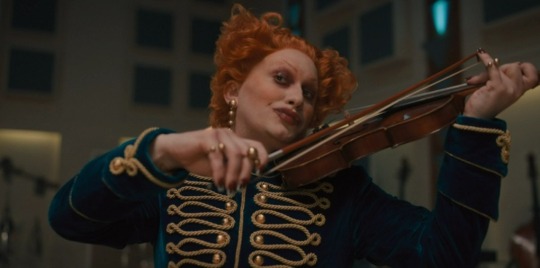
I realize this might be controversial to say, but Ncuti Gatwa is my favorite actor to portray the Doctor. He's a fantastic actor and the energy he brings the role is so different and wonderful. When it comes to media, people typically don't like to hear you praise the modern bits over the older stuff, but this most recent run of Doctor Who with Gatwa is consistently more interesting and enjoyable than any other season of Doctor Who (that's probably Davies doing).
That all said, The Devil's Chord is a wild episode. I previously said that Doctor Who has a spectrum, from really great story telling to really goofy. If Midnight is the great story telling, then The Devil's Chord is the goofy. In this episode the Doctor and Ruby must face off against Maestro, the God of Music, who wishes to take all music from the world. The energy of this episode is wild, with Ncuti Gatwa's take on the Doctor going up against the insanely wild trickster character Maestro, who is portrayed by the trans actor Jinkx Monsoon. If you've fallen off of late Doctor Who, or you are completely new to it, please give this new season a watch (and don't let the Beatles jump scare at the beginning stop you, I swear there's no Beatles music!).
09 - The Empty Child / The Doctor Dances (S01, E09&E10)

If you're starting your Doctor Who watch at the beginning of the modern series, this will probably be the first episode that strikes a real chord with you (well, other than Dalek that is). This was the show's first real attempt at telling a horror story, one that is sort of zombie adjacent. This bizarre World War Two story with a child in a gas mask morphing people's bodies and existences into more versions of himself is one of the more original stories in the entire Doctor Who series, no one but Eccleston and Billie Piper could have sold this so well. Not to mention the introduction of Jack Harkness! (We'll uh...we'll ignore the actors conduct for this...)
08 - Planet of the Ood (S04, E03)

This is not the first time we meet the Ood, they were in the aforementioned Impossible Planet episodes, however this is when the Doctor finally does what he should have from the very start. The Ood are essentially a slave race, and in Planet of the Ood, they finally start to act out and revolt. The Doctor, as unpolitical as he has always been according to some people, decides “Yeah! Slaves are wrong!” and starts working with Ood Sigma (who becomes a recurring character kind of) in freeing the Ood. This episode also has one of the sickest, most awesome, kinda horrific effects in all of Doctor Who. Above all else, this episode is just very beautifully shot and well made. One of the highlights of the entire series.
07 - The Day of the Doctor (50th Anniversary Special)
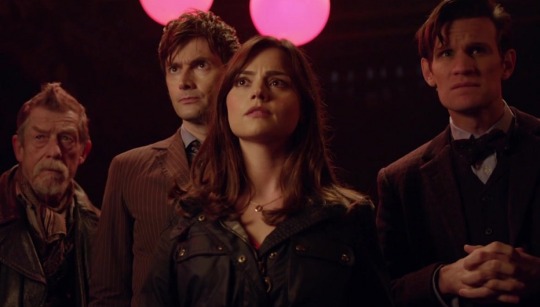
Exploring the Doctor's mind during the Time War is such a cool concept. It's a thing the Doctor keeps referring to as this horrific, life changing thing for him, and getting even a glimpse into it is guaranteed an amazing time. Featuring both David Tennant and Matt Smith, while bringing on John Hurt of all people because Eccleston wouldn't reprise his role, the acting talent in this special is incredible and genuinely so wonderful to watch. At the end of the day, it's a really, really good Doctor Who romp and deserves any praise it gets.
06 - The Waters of Mars (2009 Autumn Special)

Pic from the BBC. Theirs looks better than anything I could get.
Hey look! It's the Hugo award winning special! And I only put it at number six!
Everything about this special is so fucking cool. The set designs, the costumes, the fucking monster itself, everything in this is so cool. You know how people always joke about horror needing to be wet? Well this is wet horror. David Tennant puts in so much effort here, struggling with what he wants to and what he has to do, the Doctor is really pushed to some stressful limits here that has such a fantastic end to it. Even if you disagree with where I placed it on this list, there is no doubt that The Waters of Mars is among the best stories Doctor Who has ever put out.
05 - The Impossible Astronaut / Day of the Moon (S06, E01&E02)

This is one that's probably going to get some pushback. I am an X-Files fan, it's my favorite show, love it when it's great and I love it when it's trashy. This two part season opening is the most X-files like the show ever gets, and I am so into it. The opening mystery of the episode sets up a really cool overarching concept for the season (don't ask if it's resolved well, please don't ask that) while introducing us to one of the coolest enemies Doctor Who ever made (please don't ask if they stay that way, please don't ask that). Everything about this is so fun and interesting and I hope others come out of it feeling the same way.
04 - Voyage of the Damned (2007 Christmas Special)
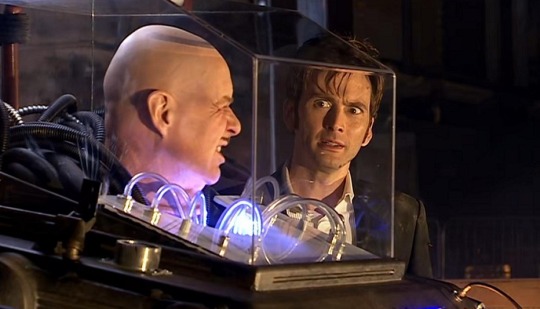
Pic from IMDB.
DOCTOR WHO TITANIC IS VERY GOOD!! Sorry for yelling. For a long while this sat as my absolute favorite episode of Doctor Who. Journeying alone on a rare occasion, the Doctor finds himself spending Christmas aboard the space Titanic (I am not kidding, they named it the Titanic!) and as the name of the ship would imply, tragedy strikes. This story is really wonderful, we get to see the Doctor try his hardest to save people and show love and kindness to so many people, not to mention having a group of characters instead of one companion to explore. I especially love the Van Hoff couple, who are two fat and poor people who won tickets to come aboard what is a wealthy cruise. Everyone around them is rather classist and fatphobic to them, but of all they characters in the special, they exhibit real happiness and love and their devotion to one another is genuinely so wonderful.
As I said, this one stood as my favorite episode for a long time. And, you don't really need to see any previous episodes to watch it, so please go watch it. It's a fun time.
03 - The Giggle (60th Anniversary Special)

I don't know what the wider fandom's thoughts on the 60th Anniversary Specials are, so I don't know if this is a controversial take or not. But, The Giggle highlights everything that is great about Doctor Who. It tips its scales back into the goofy part of the spectrum, but that goofiness is ultimately what makes this such a fun and interesting special. When thinking of actors like Neil Patrick Harris, who are so big and popular and well known celebrities, you forget that the popularity came from the fact they're good at their craft, and if The Giggle did anything for me, it was reminding me that yes, Neil Patrick Harris is an outstanding actor. And, getting put with a returning David Tennant and Catherine Tate really just solidified this special as some of the best acting the series has to offer.
The scene where the Toymaker forces the Doctor and Donna to watch a puppet show about the fates of the Doctor's companions is one of the best meta commentaries the show ever did about itself. The introduction of Ncuti Gatwa is pulled off in a fantastic way. And, the ending is so heartwarming that it makes makes me happy they brought Tennant's Doctor and Donna back.
02 - Heaven Sent (S09, E11)

I previously said that Ncuti Gatwa stands as my favorite Doctor. But, before the Gatwa episodes were out, my favorite was Peter Capaldi. Though Capaldi was given some of the worst scripts of the series (Jodie Whittaker probably got the worst of the worst), he brought such a different interpretation to the Doctor. David Tennant and Matt Smith's Doctors, despite their differences, were largely the same characters. Capaldi's had more of that Eccleston-esque attitude and charm, while bringing this gravitas that makes the silly moments feel real emotionally.
Which brings me to Heaven Sent, which might be the pinnacle of acting in the series. When people think of the best Doctor Who episodes, they probably expect big action and lots of adventure, but to me, the most interesting parts of Doctor Who are when we explore the Doctor as a character. What makes him tick, what makes him who he is, why is he here doing this – exploration of the Doctor and his motives is spectacular, especially when done right. Heaven Sent follows the Capaldi Doctor, after the death of his companion, imprisoned in a castle where he must reveal all his secrets. The torture and sorrow that Capaldi is able to show on his face is both horrifying and spectacular, really showing that he is an outstanding actor. There is no other piece of television like Heaven Sent.
01 - Vincent and the Doctor (S05, E10)

I don't think this is a surprise to anyone. I'm sure everyone has seen the gifs go around of the Doctor taking Vincent van Gogh to the future to see how his work is revered and loved and how moving that scene is. What I don't think most people know is how after that scene, after Vincent has been put back in his own time, the museum doesn't change. There are no new paintings. Amy, the Doctor's companion, then must learn that love and praise alone do not cure mental illness.
This episode has a haze of melancholy. The Doctor may change history plenty of times, but he doesn't often change real events. So, from the very beginning, you know van Gogh's fate, and you know it won't be changed. I actually liked this episode' portrayal of mental illness, it really is something that affects our lives, and makes it hard (if not impossible) to fit into society. How people with mental illness are often outcast, harassed, and treated like subhumans. But, this episode also shows happiness, hope, and love. And, that people do love you, no matter what you may think.
And, I think that makes it the best episode of modern Doctor Who.
Tumblr has decided that adding my full episode rankings would make this post too long. So, I will be adding them in a second reblog (check notes if you want to see!)
197 notes
·
View notes
Text

"Magia Record Puella Magi Madoka Magica Gaiden" Review Dialogue | Director x Main Scenario Writer
This is a quick overview of this article featuring a dialogue interview between Taguchi, Director (COO) and Director of f4samurai, and Mori, who served as the main scenario writer for MagiReco.
- MagiReco has been in development since 2015. Some of the staff have worked on it for 9 years.
- Originally, only 3 members were assigned to work on it. This included Taguchi and Mori.
- Taguchi continued to work on the project up until the release of Last Magia / the end of Arc 1. Mori continued to work on it until the end.
- The first Azaleas event (our first branching event that had “bad ends”) was not planned at the start of release. This event type was developed in the 2 months prior to appearing in game.
- Arc 2 (which completed in 2022) was something they’d been working on for three years.
- Roughly speaking, the total of MagiReco is 8,390,000 characters. Mori probably wrote about 3 million characters directly, including events and Magical Girl Stories.
- That word count is estimated to be about 70 light novels (80,000~120,000 character books) worth of content for the entire game.
- In regards to Puella Historia, Mori said, “I started with the idea of portraying magical girls who appeared in history as they appeared in the original work, but in the end it became a completely new approach to portraying magical girls from other past eras, which was fresh and interesting as a scenario writer. As expected, it was not possible for one person to do the historical research alone, so it was great that we were able to share the scenario with everyone.”
- They remark that given the nature of gacha games, it’s uncommon to write about character death. Mori notes it made Main Story a little more predictable since they were limited by this to some degree.
- Including spin-off characters, there were more than 150 characters represented in MagiReco.
- Mori notes that there were fans who supported each character, so when he could he made an effort to explore them in events.
- Taguchi asked if there were any scenarios that Mori thought had a particularly strong response. Mori noted, “The storyline with Sena Mikoto, the last boss of Part 2, received a great response and left a strong impression on me. As some users may have noticed, Mikoto was originally not intended to be the last boss at all. We were very excited and happy when we were able to show her off at the event.”
- The two comment that the release of Ultimate Madoka for first Anniversary did so well and got them number 1 rank on the App Store in sales at that time.
- Mori notes that the final story had a lot of influence from the publisher (Aniplex) on how it should play out.
- In regard to Magia Exedra, they note that MagiReco will be tied to it.
- Mori was responsible for the design and scenario behind Namae and the Lighthouse, but will be working on other projects. However, there are people on from the original scenario team who continue to be involved in scenario production for Exedra.
156 notes
·
View notes
Text
So there's a statistic I'm attempting to track down that is evading me and I am getting very frustrated by it but will report back on my findings later, but in the meantime, we're going to play a game of chase the citation.
I went looking for information about predation of housepets by native wildlife, so I start with the simple search "predators eating cats and dogs study." I use DDG as my daily driver, but I get better hits on peer-reviewed research when I use Google, so I google it and I get a link to the site Newser, which seems kind of garbagey but whatever it's got the story. I click through, which takes me to a story from the SFGate. This is a more in-depth report than the one from Newser, but nearly every link in the article is to a SFGate search of that term, not an outlink to a study or anything like it (there is a link at the bottom to learn more about a seminar, but it has nothing to do with the study under discussion). But, there's a better description of the study in the SFGate story, so I go back to Google with the search term "department of fish and wildlife; mountain lions eating cats study." The first link that *isn't* the SFGate story is Field & Stream, and the link leads me to a blog post. The first link in the blog post is back to SFGate, and the second link is, weirdly, to Patch.com reporting back on the same SFGate story. That site has the *awful* headline "California Mountain Lions are Eating Our Pets: Report" BUT the Patch.com writer went out and did at least a tiny bit of digging and so this shows up in the middle of that story:
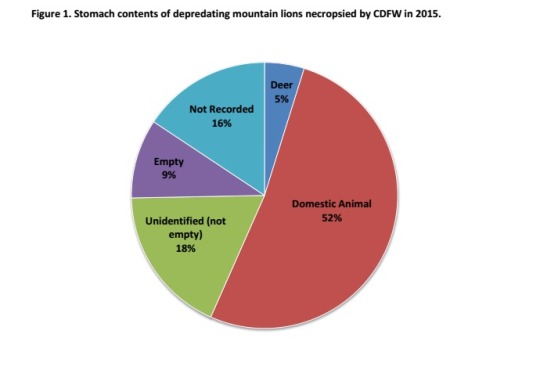
So now I have another search term, "Stomach contents of depredating mountain lions necropsied by CDFW in 2015."
So I run a search on that term and the report doesn't show up, but what DOES show up is the depredation report for mountain lions in 2022, which has some very different results!

And that's at least some of the information that I'm looking for, but I want the report from 2015 so I go back to my search and click on one of the "search term not included, do you want only results with this term" links for "2015" and the correct report is the first link, with the Patch article as the second.
One interesting thing that the 2022 report has that the 2015 report does *not* is a graph with the inciting incidents that led to the issuance of a depredation permit, most of which were for goats and sheep in 2022, with very few permits issued for domestic animals. I can't draw any conclusions as to why necropsied mountain lions in 2022 were less likely to have eaten cats and dogs than necropsied mountain lions in 2015, but I'd be willing to put more weight on "the people requesting permits did so after livestock attacks rather than the loss of a domestic pet" than "mountain lions just stopped eating cats and dogs."
Anyway, this report doesn't connect to anything I'm talking about in a meaningful way, it's not like a huge deal or whatever. But if you are a reporter discussing "a recent report" and you don't link to the report I am going to fucking eat *you.*
321 notes
·
View notes
Text


By: Christina Buttons
Published: Apr 4, 2024

[ Figure 2: Representative images of Hematoxylin and Eosin-stained sections of testicular tissue biopsied from the testis from GD patients (A) with and (B) without PB exposure. ]
In a groundbreaking study from the Mayo Clinic, a globally recognized leader in medical research and patient care, researchers examined the effects of puberty blockers on testicular development in gender dysphoric male children. Their investigation revealed evidence of mild to severe atrophy in the sex glands of these children, leading the authors to express doubt in the claims of “reversibility” often made about puberty blockers.
The authors assert, “We provide unprecedented histological evidence revealing detrimental pediatric testicular sex gland responses to [puberty blockers].”
This preprint study, not yet peer-reviewed, presents evidence that puberty blockers induce significant cellular changes, impacting testicular development and sperm production in ways that are not fully reversible, with potentially permanent effects on testicular function and fertility. It challenges the longstanding view of puberty blockers as a reversible "pause button" on puberty.
As noted by the researchers of this study, no long-term studies exist for the use of puberty blockers in the context of stopping puberty for gender dysphoric children, and many potential health consequences remain unknown. In particular, the long-term impact on reproductive health is uncertain, making this study critical for filling this knowledge gap.
To address these unknowns, the Mayo Clinic has established the largest collection of testicular samples for patients aged 0-17 years, including those with gender dysphoria who have and have not yet received puberty blocker treatment, creating a database of over 130,000 individual cells for analysis.
Using a novel approach, the research team meticulously analyzed testicular tissue samples from youths undergoing puberty blocker treatment, with those not on puberty blocker treatment serving as controls. This comparison provides important insights into the potential cellular and molecular changes induced by these drugs.
Key Findings
The study utilized the Mayo Clinic's Pediatric Testicular Biobank for Fertility Preservation, which has been recruiting patients primarily from pediatric urology departments since 2015. Researchers analyzed testicular specimens from 87 young individuals (ages 0-17) undergoing fertility preservation surgery for various health reasons. Among these, 16 were gender dysphoric boys between the ages of 10 and 16, all of whom began identifying as transgender girls between the ages of 2 and 15. At the time of surgery, 9 patients (56%) were already on puberty blockers, with exposure ranging from 3 to 52 months. The authors noted that 100% of the 16 children would eventually go on to take them, highlighting “the widespread nature of PB intervention in this demographic.”
Among nine patients treated with puberty blockers, two exhibited unusual features in their testicles upon physical examination. One patient had abnormalities in both testicles, including incomplete development of the tunica albuginea, which is a protective covering around the testicles. The other patient had a right testicle that was difficult to detect.
In one part of the tissue-level analysis, over 400 testicular biopsy samples were analyzed and stained to examine the differences between those treated with puberty blockers and those who were not. Comparisons showed that testicular development in those treated with puberty blockers was abnormal compared to non-treated individuals. There was variability in how individuals responded to puberty blockers, leading to different outcomes in testicular development, including the degeneration of testicular tissues.
The study authors presented a case of a 12-year-old patient who underwent treatment with puberty blockers for 14 months. In this individual, 59% of the sex glands showed complete atrophy, along with the presence of microlithiasis—a condition where small clusters of calcium form in the testicles. This insight suggests that puberty blockers could lead to lasting structural changes. Additionally, research has shown a link between testicular microlithiasis and testicular cancer.

[ D) Representative images of normal (top) and fully atrophied sex gland (bottom). ]
This study also utilized single-cell analysis to investigate the effects of puberty blockers and aging on testicular cell composition. It took a very detailed look at individual cells from the testicles of a 14-year-old who had been on puberty blockers for over 4 years. The study analyzed a total of 130,100 cells, including 11,199 cells from the juvenile puberty blocker-treated patient.
The study observed that over 90% of the cells responsible for sperm production in this patient were stunted at an early developmental stage, unable to progress further. Additionally, it found "pathologically" higher and lower levels of two types of support cells (Sertoli cells) necessary for healthy sperm development. These findings suggest that puberty blockers can disrupt the normal maturation process of cells critical for sperm production.
In another part of the analysis, the authors found distinct cell-specific changes, including altered expression patterns of puberty-associated genes in endothelial cells, due to puberty blocker treatment. The authors believe that these drugs might induce juvenile testicular atrophy in part by disrupting the normal function of testicular endothelial cells.
Another aspect of the study focused on examining the effects of puberty blockers on the genetic activity of early-stage sperm cells, revealing significant changes that could potentially influence their development and fertility. By analyzing the activity of specific genes within these cells, the researchers found that puberty blockers may have caused alterations in gene expression, affecting processes crucial for the normal growth and function of these cells. This analysis suggests that the use of puberty blockers in gender dysphoric youth could have lasting implications for their reproductive health, particularly by impacting the ability of these early-stage sperm cells to mature properly.
Study Impact
Puberty blockers are increasingly used as a treatment for gender dysphoric youth to halt the development of secondary sex characteristics, such as breast development and widening of hips in females, or the growth of facial hair and deepening of the voice in males. Thousands of children in the United States are placed on this medical pathway as part of the gender-affirming model of care, under the presumption that these drugs are safe and fully reversible.
However, many aspects of the long-term consequences of puberty blockers, which have been administered to children off-label in an experimental manner, remain unknown. This study contributes valuable insights into the potential irreversible harm these treatments can cause to bodily and reproductive functions.
Arguably, the most critical finding is the evidence of mild to severe sex gland atrophy in children treated with puberty blockers. This atrophy signifies potential damage or impairment to the structures essential for sperm production, raising serious concerns about the long-term fertility impacts of these drugs for these individuals.
Given the Mayo Clinic's esteemed reputation in the medical and research communities, should the study pass peer review without any issues, its findings will carry significant weight.
Broader Implications
Puberty blockers belong to a group of synthetic gonadotropin-releasing hormone (GnRH) analogues. These drugs act on the pituitary gland to hinder the release of chemical signals that typically trigger the production of estrogen and testosterone. Historically GnRH analogues were used to treat conditions such as prostate cancer, fibroids, and endometriosis and, in some cases, as a measure to chemically castrate sex offenders.
In children, puberty blockers prevent the natural changes of puberty driven by sex hormones and have been used to treat central precocious puberty, a condition where a child begins to sexually mature much earlier than usual. In gender dysphoria, puberty blockers are administered experimentally, lacking long-term testing.
Notably, the U.S. Food and Drug Administration (FDA) has not approved puberty blockers and sex hormones for use in pediatric gender care. No clinical trials have substantiated the safety of these drugs for such non-approved applications and manufacturers of puberty blockers have repeatedly declined to conduct safety trials for their use on this cohort.
While puberty-blocking drugs are often promoted as “safe,” "reversible" and a "pause button" on puberty, these characterizations seem to stem from their approved use for treating central precocious puberty in younger children, not their burgeoning off-label use for managing gender dysphoria in adolescents.
Past studies have indicated possible negative effects on bone density and brain health. There is also a concern that these drugs might solidify gender dysphoria in adolescents, potentially leading them down a lifelong road of biomedical interventions. Following reports in 2016 of suicidal ideation in children administered puberty blockers, the FDA instructed drug manufacturers to include a warning about potential psychiatric issues on the drugs' labels.
Puberty blockers are increasingly administered to adolescents at Tanner Stage 2, the first signs of puberty. Research shows administering puberty blockers at this stage, followed by cross-sex hormones, may result in infertility, sterility, and sexual dysfunction. Furthermore, they inhibit the development of mature male genitalia, making it difficult to create a pseudovagina in the event of a later vaginoplasty due to a lack of sufficient tissue.
The National Health Service England recently announced it would no longer prescribe puberty blockers to youth outside of research settings and closed down its only national clinical service for pediatric gender medicine, following a review that deemed the service "not safe.”
Several European countries, including Sweden, Finland, the UK, Denmark, and Norway have updated their guidelines for youth transition to align with systematic evidence reviews, the gold standard in evidence-based medicine. These reviews concluded that the risks associated with youth transition outweigh any purported benefits. Consequently, these countries have implemented restrictions on medical interventions, prioritizing psychotherapy as a first-line response for minors experiencing gender-related distress.
==
They're sterilizing boys and giving them cancer. When "god" does it, we call him evil. When humans do it, we call it "gender affirming care."
#Christina Buttons#puberty blockers#atrophy#medical scandal#medical malpractice#medical corruption#sterilization#fertility#irreversible#gender affirming care#gender affirming healthcare#gender affirmation#queer theory#gender ideology#gender identity ideology#intersectional feminism#religion is a mental illness
231 notes
·
View notes
Text
Doctor Strange's disability: a (much needed) chronological review
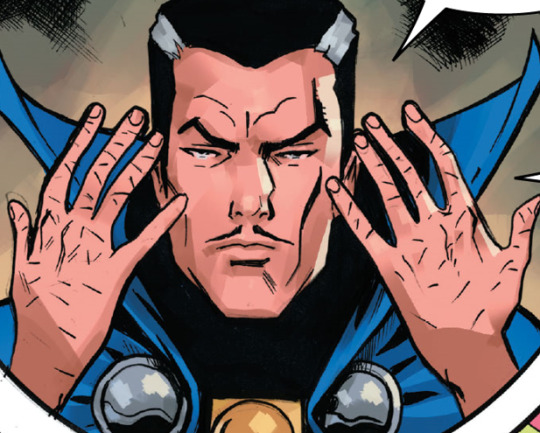
In view of recent ableism and drama on the other social hellsite involving Doctor Strange's disability, here's my response, based on *CANON* material. (link to the thread on said hellsite here)
Stephen disability is established since 1963, back in Strange Tales #115. The story is focused on a flashback which portrays his journey from the decay of his medical career because of a car accident to his path towards the mystic arts.
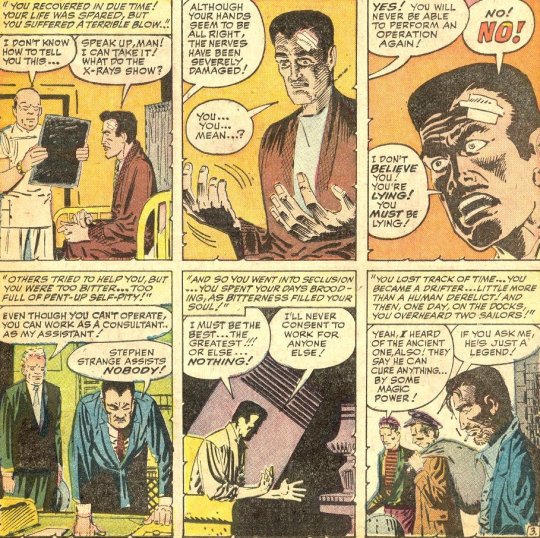
Note that, in this very same issue, the Ancient One never says he would heal Stephen's *hands*, but perhaps Stephen would find the cure within. In other words, Stephen was supposed to heal his heart and soul from arrogance and egoism through magic, not a physical cure.

Also note that there are limitations within every aspect of comic books' universes. In this case, we're talking about magic. Magic is not a miracle thing. It demands training and, most recently as established by v4, a cost (Doctor Strange v4 #4).
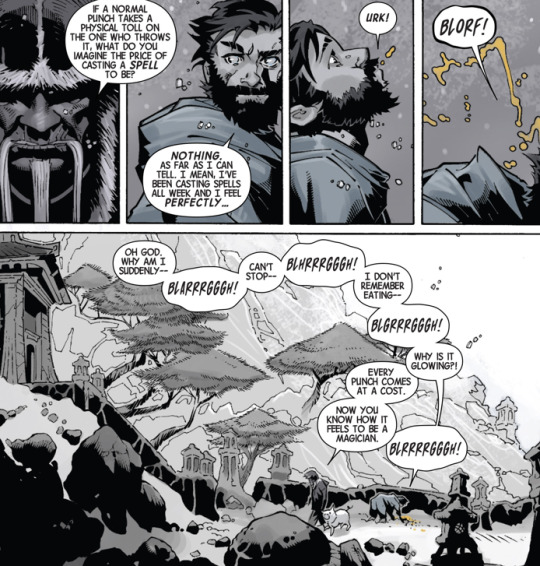
Another clue that "magic can heal anything because it's fantasy" is not a valid argument within Marvel's magic world, as seen in The Oath. Stephen had access to the Otkid's Elixir, which could heal any disease, but the formula was lost in order to save Wong's life.

One last example comes from Spider-Man Family #5 (2007), featuring Morbius and Spidey. It establishes that healing demands the exact same price when it comes to magic.

Long story short, it's clear that the magic side of Marvel does not offer a solution to diseases through magical miracles. So this argument is totally invalid ~within~ this established universe.
Now back to Doctor Strange... No, he isn't using magic to heal his hands unlike some misleading accounts are claiming. In fact, there are several panels which show that he's actually in constant pain. Here's some examples:
- Doctor Strange - Sorcerer Supreme #48 (1992).
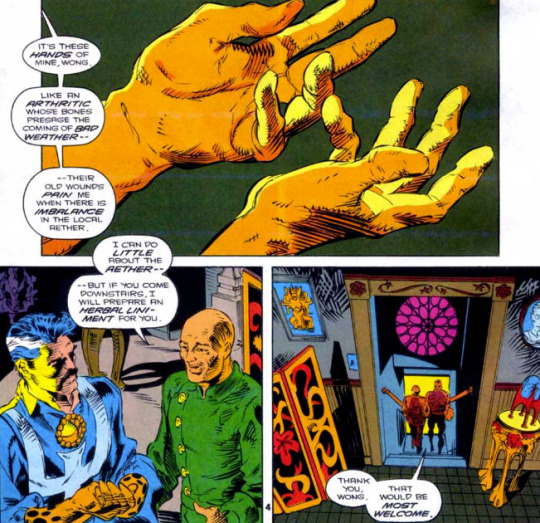
- Captain Marvel v10 #6 (2019)
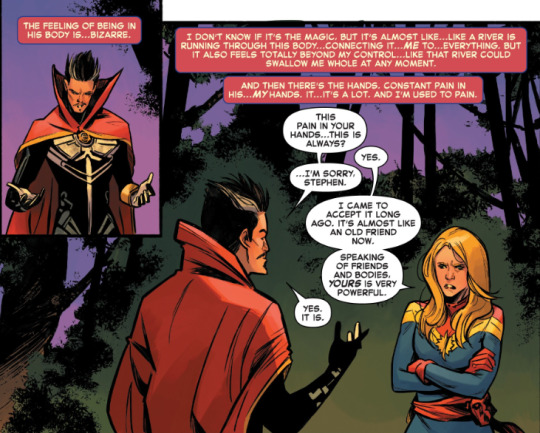
- Doctor Strange v4 #1 (2015)
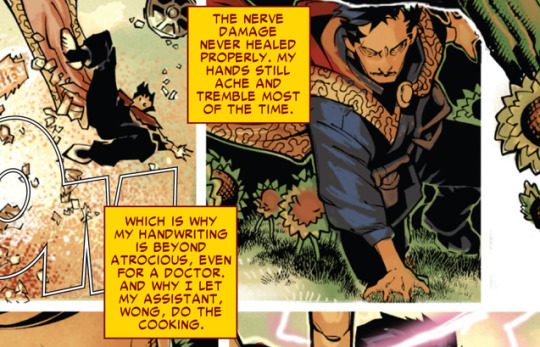
He also struggles to hold a pen and write, relying on magic to do so, as seen in the Book of the Vishanti.

Then comes the stupid argument I saw.
"Oh, but Google says his hands are healed!" is not a gotcha moment you think it is. We had FOUR MAIN BOOKS after that (Surgeon Supreme, DODS, Strange v3 and current v6). Allow me to clarify the details in chronological order.

Stephen indeed made a "magic" gamble and healed his hands. That much is correct. But it's not all (panels from Doctor Strange v5 #19 - 2019).
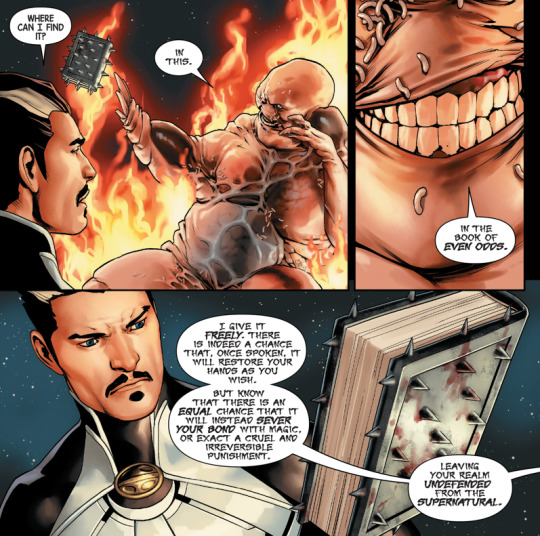
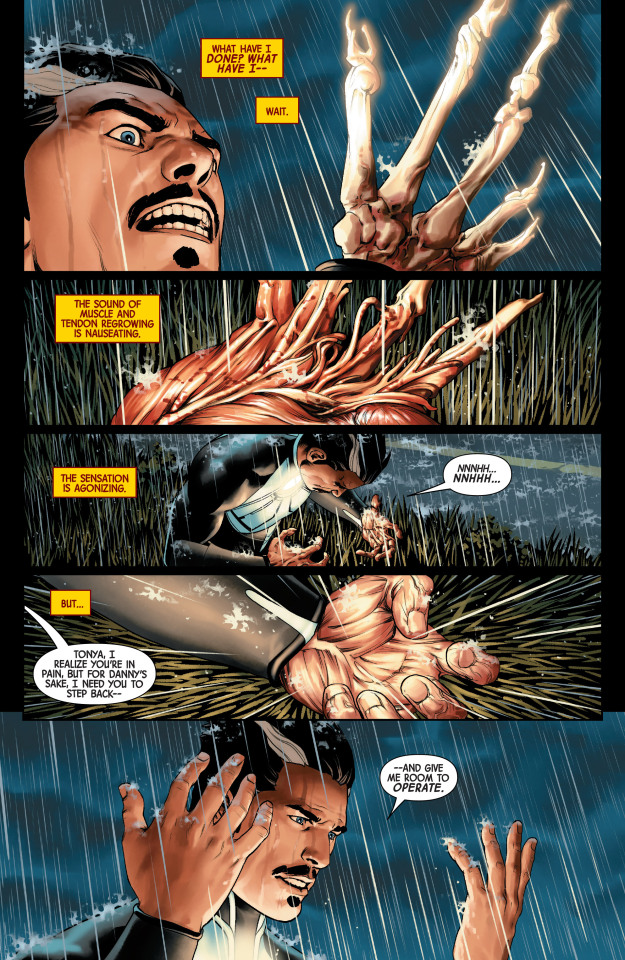
Waid continued this storyline in a new book called Dr. Strange (Surgeon Supreme), which would portray Stephen's duality as the Sorcerer Supreme and a brilliant surgeon. Except the book was cancelled at issue #6 (2020), leaving the character in a kind of limbo. Now enter MacKay.

MacKay kept a little bit of the former storyline as seen in Death of the Doctor Strange #1 (2021). On top of that, his hands appeared healed. However, that lasted only until Kaecilius murdered Stephen and stole his hands.
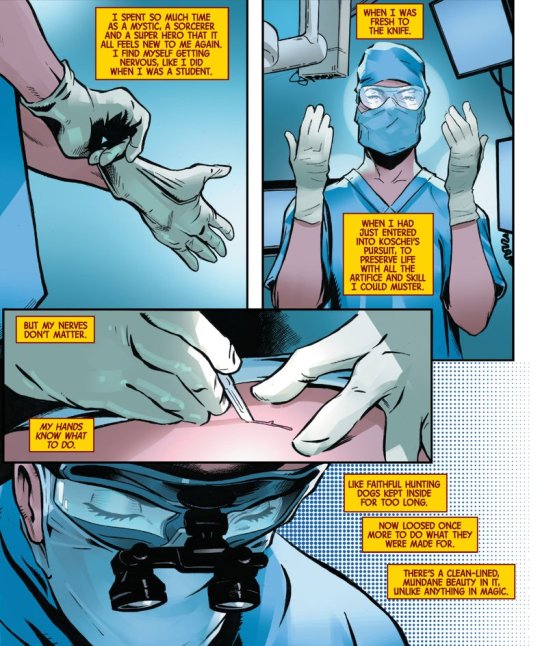
Stephen's temporal duplicate used a regenerative spell to bring original Stephen back through Kaecilius' body and the stolen hands. In here, we can see that his hands are scarred just like after the car accident (DODS #5 - 2022). OG Stephen died a second time with scars as well.


Stephen is indeed seen writing in v6 but it's not clear if he's using magic or not. Besides, he's not working as a surgeon anymore. Moreover, MacKay considers Stephen disabled as seen in this recent issue of v6 (#7 - 2023): "My own connection to the aether, the magic of the world, the power of the Vishanti, the power of the Sorcerer Supreme... Gone. Without all of that? I am just an old man with useless hands and a blade in his stomach."
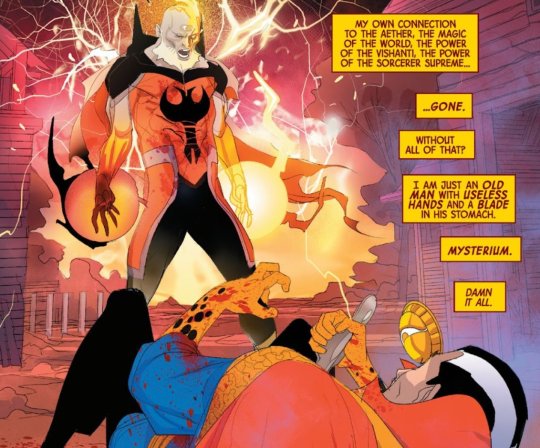
In conclusion,
As of CURRENT DOCTOR STRANGE RUN by Jed MacKay and Pasqual Ferry, in the year of our lord Vishanti, 2024, Stephen Strange is a disabled character and no magic or ableism will erase that. Thank you very much.
206 notes
·
View notes
Text
i finally articulated my opinion on my "is gerard way doing drag" question. my definition of drag is when a person impersonates, exaggerates, or appropriates a mode of gender expression. drag can be artistic or political (or both). drag can be an identity. drag and transgender identity are confused as the same thing. for some, it is. what is considered cross dressing can also be considered drag. it's important to note that drag is essential to queer culture, and how the us government harasses queer people through cross dressing, and now anti-drag, laws. we wouldnt be here talking about pop artists doing drag without drag performers and nonbinary-trans-gnc people.
to some people, a self-identified man in a female-identified dress is drag. "cross dressing" depends on cishet norms. queer people, especially nonbinary-trans-gnc people, have called to dismantle the assignment of gender to clothing. under that lens, a man in a dress is just a man in a dress -- for it to be drag, context and intent matters. that's how you get women doing female drag, or androgynous people doing what gerard way's been doing this last year on tour.
in asking "is gerard way doing drag?", im assigning importance to the topic. does it matter? within my understanding, drag is about intent and context as much as gender presentation. intent and context is what makes something important. therefore: understanding why the question is important solves it.
male music artists have a long history of cross dressing and doing drag. there's a good chance plugging any dude into a search engine with "drag" or "skirt" will bring something up. bowie, queen, nirvana, manic street preachers, placebo. here's a list. newer artists: lil nas x, harry styles, anthony green, pete wentz, young thug. some are impersonating female caricatures, some are masculinizing female clothes (long, ill-fitting, straight). some, like molko and lil nas, wear feminine clothes without exaggerating or masculinizing. gerard is in that same grey area.
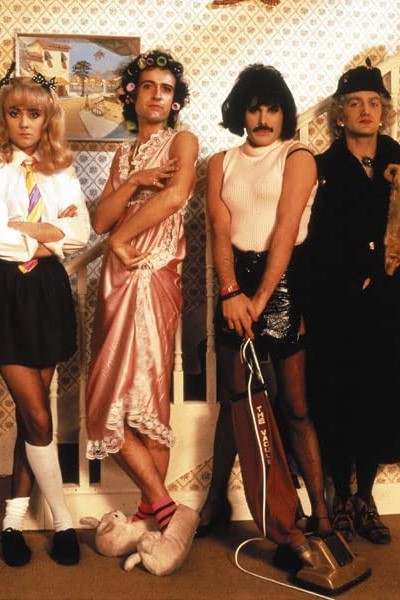



male music artists have a long history of cross dressing and doing drag -- photos: "i want to break free" mv by queen (1984) / placebo in london (oct 1998) / lil nas x at audacy beach festival (dec 5, 2021) / fall out boy at rock for people (june 17, 2022)
all that history is why it was so weird when kerrang called gerard's riot fest "dress and heels" "a compelling show of contrarian anti-rock star eccentricity". it is not anti-rock star, at least not as described. it may be compelling, contrarian, and eccentric, but no reviewer really cares to analyze why. the closest they get is by identifying non-binary connection (them.us) and its relation to the "minefield that is American gender politics today" (latimes.com).
fans were struck by way's outfits for a lot of other reasons.
1. we have to get it out of the way that they just looked hot -- gerard is perpetually attractive, skirts are pretty. easy equation.
2. he has a long history of gender nonconformity. more on that in my #mcr queer studies tag. gerard is a 45 year old famously androgynous person who doesnt do labels, aligns himself with gender nonconformity (2014 reddit ama, 2018 advocate article, 2015 he/they tweet), and doesnt seem to care to be known as a man.
3. the tour outfits were well-fitted. many were crafted by skilled designer marina toybina and her team. which leads to ->
4. the outfits were very casual and very feminine. as mentioned, most men opt for masculine, ill-fitting skirts. which is to say they are NOT showing leg and they are definitely not showing ass. gerard doesnt steer clear from shortness or tightness or movement. he also dresses in ways people dress day to day -- the miniskirt is as casual as the shorts as casual as the jeans. there's some discussion to be had about what casual means -- he could be imitating expected presentation or just using basics, like his frequent shirt and pants.



the miniskirt is as casual as the shorts as casual as the jeans -- photos: firefly music festival (sept 23, 2022) / uncasville (sept 1, 2022) / eden project night 1 (may 16, 2022)
5. there was variety. many outfits, many types. he wasnt just doing pure femininity. some looks were high concept, some low concept. some gendered, some genderless. some feminine, some masculine. it was playful. its honesty evident in its fluidity yet cohesiveness. expanded in the next points ->
6. they incorporate elements of masculinity and gender neutrality concurrent with the feminine. his aggressive, energetic performance style often doesnt mind what people are seeing when his skirt lifts or shirt droops. he has little to no make-up -- if he does, it's stage and not glam. the closest he gets is the agender black swan look at boston night 1, the stage contour at wwwy night 3, and dubious lipstick at firefly. he also maintains the same hairstyle: barely styled, not straightened-curled. pinned a few times, gelled back some other times.



he has little to no make-up -- if he does, it's stage and not glam -- photos: boston night 1 (sept 7, 2022) / when we were young night 3 (oct 29, 2022) / firefly music festival (sept 23, 2022)
7. the character outfits weren't caricatures, like green's sleazy hooker or queen's uptight housewives. gerard's characters were appropriated but not exaggerated. cheerleader, nurse, manson girl, jackie o, princess diane, st joan. all figures of pop culture. he wore them as they were. even comparing green and way's similar white-green cheerleader costumes there's a difference in presentation. green wears long leggings, way wears shorts. green's costume is based on a stranger things character, way's is a custom remade vintage outfit. green exhibits the masculinization of feminine clothes which way subverts. this comparison highlights what makes way's outfits different, and therefore exciting to talk about.


green exhibits the masculinization of feminine clothes which way subverts -- photos: saosin in garden grove, ca (oct 27, 2022) / mcr in nashville, tn (aug 23, 2022)
8. and when he played with masculinity, it was in a way that was dubbed "boydrag". the new jersey night 2 casino singer look was a dramatic caricature that heightened masculine features until they were pure style... the defintion of camp. he had a mustache -- thin like john waters or a confirmed bachelor, and drawn on with eyeliner. he had a suit -- a pink-gold, glittery woman's cut jacket with a glittery bowtie and pleated shirt. the dramatic flair is accentuated by the black eye make-up, the frank sinatra "my way" cover, the drum tag: "the house always wins".


the defintion of camp -- photos: new jersey night 2 (sept 21, 2022) 1 / 2
when i asked which outfits others considered drag, all replies identified the casino singer and jackie o as drag and the rest as "just clothes". this relation made me understand why the rest couldnt be drag despite all the connections i talked about above. the jackie o outfit doesnt exaggerate the source like casino singer, but the source itself is both highly dramatic and highly gendered. cheer is gendered but not highly dramatic, st joan dramatic but not highly gendered. diane is gendered and dramatic, but not highly. the list goes on and on. it's a fine line. especially cheer could tip into drag for me.


but the source itself is both highly dramatic and highly gendered -- photos: mcr at riot fest (oct 12, 2022) / jackie kennedy onassis (jan 3, 1971)
if drag is understood in this way, simply wearing gendered clothes isnt drag. the look itself has to be about the performance of gender, however that may be presented. that’s the importance of classification. we can see what the artist is doing.
1K notes
·
View notes
Text
Dragonball Z: Abridged Episode 3 Review
Originally posted August 10th, 2015
When god is a dick, things can be pretty fun.

“Happily Ever Afterlife” is one of the unfortunate “intermediate” episodes of Dragonball Z: Abridged, which is to say, it’s an episode that is required to exist, so that there are no gaps in the story, but beyond filling in the details between plot point A and plot point B, it doesn’t actually advance the story by any significant degree. As a result, the pace of the story in this episode is very slow and meandering, which would be fine, if Team Four Star were good at telling slower stories. But, at this time, Team Four Star’s strengths lay in frenetic pacing and joke-a-second comedy; they are at their weakest when the story demands to be told at a slower pace, and unfortunately, “Afterlife” requires them to slow down.
That’s not to say this episode is without its strengths. King Yemma, in fact, is the strongest part of this episode; his devil-may-care attitude and lack of respect for Goku and Kami lead to this episode’s funniest moments, as Kami is forced to invoke his status as Guardian of Earth in order to get Yemma to allow Goku to travel to King Kai (while simultaneously serving as effective exposition for who this other Namekian is and why he’s important). Of course, Goku must travel along the apparently ominous Snake Way to get there, so even in his concession, Yemma refuses to be actively helpful.
Back on earth, Krillin is responsible for delivering the news of Goku’s death and Gohan’s kidnapping to Chi Chi, who responds with appropriate rage. This is where the episode is at its most inconsequential, as it doesn’t feel like it serves much more of a purpose than to delay Krillin from gathering the “Z Warriors” (a name that is thankfully never mentioned again), and to feed into the harmful characterization of Chi Chi as a “crazy bitch.” This is a common interpretation of Chi Chi that even Toriyama feeds into most of the time, but it’s incredibly harmful, because Chi Chi not wanting Gohan to be in danger (or kidnapped) is entirely reasonable. He’s only five years old, after all, and any mother would be completely within her right to not want her five-year-old son to be involved in deadly battles for the fate of the world.
Gohan and Piccolo also get some time together in this episode, and their relationship is developed for the first time. While we only get a brief scene with the two of them, it’s the part of the episode with the most substance; Piccolo wants to train Gohan for entirely selfish reasons, but he quickly discovers that Gohan is actively suppressing his natural talent for fighting in favor of focusing on more intellectual pursuits. It also leads to a pretty hilarious moment where Gohan calls out Piccolo for wanting to train a five-year-old to fight, since doing so would (according to science) cause his body irreparable harm. It doesn’t hurt that MasakoX (Gohan) and Lanipator (Piccolo) have both already sunk very comfortably into their characters, leaving this short scene as the best acted and written scene of the episode.
Rating: 3.5/5
If you liked this review, please consider supporting me on Patreon.
Stray Observations
1We know Snake Way is ominous because ominous music is played after it is mentioned, a type of joke that is thankfully retired soon.
Yemma: “I do have a desk though. It’s made of mahogany. Mahogany.”
Gohan: “Actually that looks more like a plateau!”
Yemma: “And not just any mahogany, but mahogany from the planet Malchior 7, where the trees are over three hundred feet tall and breathe fire!”
#dragon ball z abridged#dragon ball z#team four star#dbza#film criticism#dbza ep03#aug 10 2015#it's kind of funny to me that as soon as we get to these reviews i really don't have much to say#in a lot of ways#this series was how i came into my own as a critic#i started writing it in part because i love DBZA and wanted to look at it through a critical lens#but also because i wanted to find something to write about consistently#and those desires happened to coalesce perfectly in this weekly series of reviews#i also know i did my best to be as sharp and concise as i could with them#i'd recently spent the previous summer watching all of supernatural#and reading the AV club's reviews alongside each episode#and found that experience really rewarding#so the next logical step was to try that myself#weekly reviews of a show that i truly loved#and doing this taught me a whole lot#and made me a better writer
11 notes
·
View notes
Text
as a queer person #FellowTravelers already means a lot, but THIS episode8-finale ep-ending scene? this scene means absolutely the world, it's everything, for all of us.🌈
can't watch it without sobbing.
(please do check the WHOLE post, and watch How to Survive a Plague 2012, it's a MUST watch (+everything you spot in this post)
+important reading about AIDS/HIV: https://www.goodreads.com/review/list/139102124?shelf=about-aids-hiv
+ a special episode where we hear(literally) from listeners of the show who were lovers, nurses, relatives, students, and friends of people who died from AIDS. (have tissues nearby):https://open.spotify.com/episode/4rTjExVqMVoEtCVPISSW5t?si=Dx09EVStQAiNHoTYvwZvFw & https://www.iheart.com/podcast/269-a-bit-fruity-with-matt-ber-117844074/episode/stories-from-the-aids-crisis-191687576/
+ also queer history/facts from RWRB(Alex engaging with queer history)(thank you SO. MUCH. CASEY MCQUISTON!!)-GREAT POST here on tumblr!!-many links here, lots of information! (Waterloo Vase, Stonewall, SCOTUS decision 2015, Walt Whitman, Laws of Illinois 1961, The White Nights Riots, Paris Is Burning, THAT David Wojnarowicz photo 'If I Die Of AIDS-Forget Burial-Just Drop My Body On The Steps Of The F.D.A' https://www.tumblr.com/yourartmatters-itswhatgotmehere/757305651356729344?source=share (I encourage you to research more about David!!) , Thisbe & Pyramus, The V & A, James I & George Villiers and MORE!!) https://www.tumblr.com/yourartmatters-itswhatgotmehere/757308307835895808?source=share (Learning about things referenced in Red, White & Royal Blue, thank you @ elipheleh)
+ https://www.tumblr.com/yourartmatters-itswhatgotmehere/743725164968214528?source=share
+ https://yourartmatters-itswhatgotmehere.tumblr.com/post/746941244472786944/so-alright-here-are-the-moviesmedia-that-make
BOOKS TO LEARN MORE ABOUT BISEXUAL HISTORY & ACTIVISM:https://www.tumblr.com/ruimtetijd/686000390089621504/list-of-books-about-bi-history-and-activism-from &https://www.goodreads.com/review/list/139102124?shelf=bi-bisexual-characters-done-well &https://docs.google.com/document/d/1Q--nIkJu0OS0BgiyZmdKVwOVg1G90SFzWijNDWFTt58/edit#heading=h.wqkaxpi7o5je
+ https://www.queeringthemap.com/
+ https://www.aidsmemorial.org/interactive-aids-quilt
+ https://www.tumblr.com/yourartmatters-itswhatgotmehere/752340111366160384/this?source=share
+Thank You Howard Ashman, I love you forever, so many of us are here and sane because of Your legacy and impact.(DISNEY-QUEER SONGS-MUSIC-POST):https://www.tumblr.com/yourartmatters-itswhatgotmehere/753605532240216064/howard-ashman-i-love-you-forever-so-many-of-us?source=share &https://www.tumblr.com/yourartmatters-itswhatgotmehere/754612616112046080?source=share
about Howard, about AIDS, listen to the song 'Sheridan Square' if you haven't yet, Howard wrote it with Alan Menken. And yes, it makes me sob every single time i hear it: .https://open.spotify.com/track/5p61V1pNfa4qoZIxm6apex?si=a32ca6011ab44782 &https://youtu.be/-4fr8JGkeO4 &https://www.youtube.com/watch?v=97-NzeIkkJI&list=OLAK5uy_l7U2qdUmOPfgWwmsCA0cc_-KDxwjMj5zM +Learn more :https://stanforddaily.com/2019/06/05/sheridan-square/ & please research more about Howard, there's a lot of Him in THIS IMPORTANT post because we, queer people, owe him so so much.
♥.https://open.spotify.com/playlist/19uKl8PZixNjsMBBqSP1bf?si=e6186d9a0a824679 &https://open.spotify.com/playlist/0X8DlZ8X0q9Pzvqq857XlV?si=fa85b32666b94e74 &https://open.spotify.com/playlist/6vdBgNpWvIwjCLD2JrJwxj?si=3274258c86f842




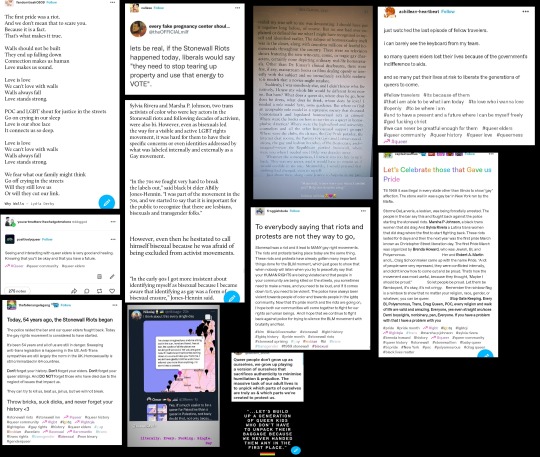
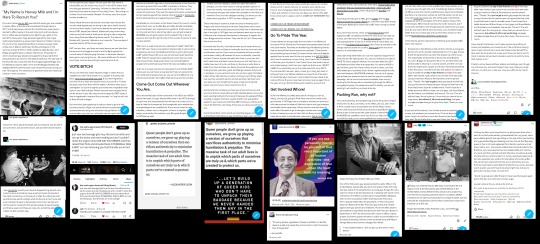

youtube


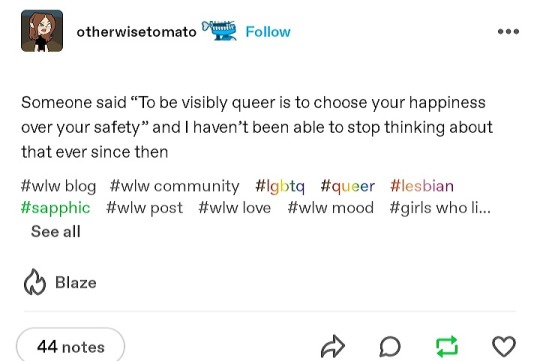


youtube
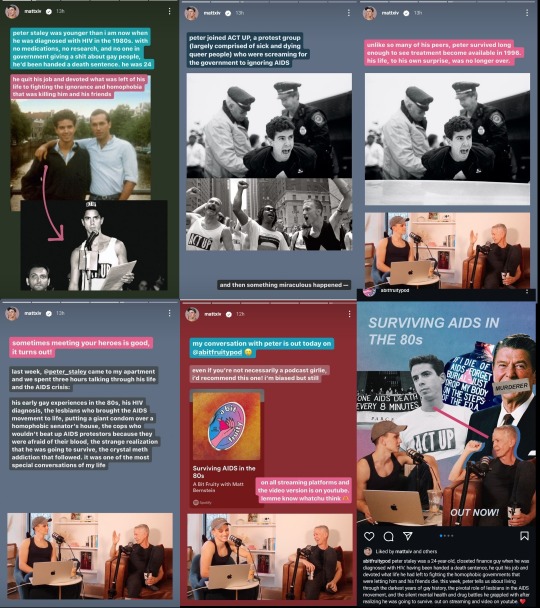

+ :

instagram
instagram








+ https://twitter.com/beames_josh/status/1500938296209199108 + https://twitter.com/beames_josh/status/1500935379154657281
+once you're here check out this important posts:
bi ig highlight : https://www.instagram.com/stories/highlights/18280848235083086/
.
#fellow travelers#jonathan bailey#matt bomer#aids#world aids day#lgbtq#lgbtqia#lgbt#queer#gay#lesbian#bisexual#matt bernstein#the normal heart#the normal heart 2014#peter staley#mattxiv#brenda howard#harvey milk#queer history#queering the map#howard ashman#marsha p johnson#sylvia rivera#stonewall#lani ka'ahumanu#david wojnarowicz#aids history#act up#aids crisis
259 notes
·
View notes
Text
Reuters’ Ethics and Standards editor told HonestReporting on Tuesday that the wire service “disputes” our “claim” that its journalists had “decorate[d] their office with terror symbols.”
This despite photo evidence we exposed last week showing scarves with terror groups insignias decorating what used to be Reuters office in Gaza in 2013:

The man in the photo is Reuters current Head of Visuals for Gaza, Suhaib Jadallah Salem. The photo still appears on his Facebook page.
Like the Nazi Swastika, the emblems on the scarves are of genocidal groups — Hamas, Islamic Jihad, al-Aqsa Martyrs Brigades — that call for the killing of Jews/Israelis (like some of Suhaib’s colleagues in Reuters).
There are only two bad explanations to Reuters’ disturbing response: ” Either it doesn’t view these proscribed terror groups as such, or it is denying indisputable evidence.
The rest of Reuters Ethics and Standards editor Brian Moss’s official response did not address our exposure of its journalists in Gaza receiving awards from senior Hamas officials.
Instead, it said: “On the basis of a close review by the Reuters Ethics and Standards department, we dispute the distorted evidence and insinuations of bias in the HonestReporting September 5th article. We stand by our coverage of Gaza and our team, who operate within the Thomson Reuters Trust Principles…Further, we dispute any claim that our journalists received ‘de-facto bribes from terrorists.'”
But here are the facts, which HonestReporting stands behind:
Our review of Palestinian media revealed that since 2015, the proscribed terror group has hosted annual ceremonies to honor Gazan journalists who had won prestigious international awards, including photographers from Reuters.
This cozy relationship between Gaza’s terror groups and the journalists tasked with covering them objectively is ethically flawed. It exposes the disturbing entanglement between terrorists and the media, shaping a distorted global narrative about Gaza.
Honored by Terrorists
In 2017, Hamas held a commendation event for international award-winning journalists in Gaza, where it honored Reuters photographer Suhaib Jadallah Salem — the agency’s current head of visuals for Gaza (who was photographed in Reuters office in front of the terror groups’ scarves.)
One of the photos from the event shows Suhaib’s brother Mohammed Jadallah Salem, a Reuters photographer who recently won the Pulitzer prize and the World Press Photo award, receiving Suhaib’s commendation plaque on his behalf. Two senior Hamas officials are granting the plaque: Khalil al-Hayya and Mushir al-Masri:

Al-Hayya has publicly called for a fight against Israel as “the head of the serpent,” and al-Masri has vowed to “uproot The Zionists With Our Axes, Knives, Guns.”
Receiving commendation from such terrorists is a mark of Cain. It should get any journalist disciplined by any respectable media outlet.
Yet Reuters journalists — knowing perhaps that their bosses won’t find out or even care — had no qualms getting into bed with Hamas. Another photo from the event shows other Reuters journalists around a table not too far from al-Hayya: Reuters Senior Gaza correspondent Nidal al-Mughrabi is sitting near Suhaib’s brother Mohammed and photographer Ashraf Amra (who was also honored at the event and exposed by HonestReporting for endorsing infiltration into Israel on October 7). Beside them is Belal Jadallah, who headed the allegedly “independent” Gaza Press House:

Suhaib himself attended a separate Hamas commendation event for journalists later in 2017. This time, he was honored for performing the Muslim pilgrimage to Mecca:

Suhaib received the commendation from al-Masri and Hamas spokesperson Fawzi Barhoum (who have often been interviewed by Reuters), along with the movement’s media officials.
It’s worth noting that four of the Jadallah brothers work for Reuters, in Gaza and Dubai. And the links of the Jadallah family to Hamas go back years. One of the brothers of Suhaib and Mohammed, Sallah, was among the terrorists who kidnapped and killed Israeli soldier Nahshon Waxman in 1994.
The mastermind behind that operation was Moahmmed Deif, who was recently eliminated by Israel. As Hamas’ military chief, Deif was also one of the masterminds behind the October 7 massacre in southern Israel.
If Suhaib and Mohammed were professional journalists, such background wouldn’t necessarily matter. But if they have been hosted and honored by Hamas, it’s alarming.
Unethical Nexus
Top news editors probably know it’s impossible to be a journalist in Gaza without links to Hamas, which controls the information flow. In other words, professional journalism in Gaza is impossible, and news outlets should admit it to their audience.
But being hosted by Hamas, receiving its commendations, and displaying terror groups’ insignias isn’t a case of journalists even trying to be professional. This is an agenda-driven, cooperative, symbiotic, reciprocal, and personal nexus that benefits each side.
A Hamas statement from one of the commendation events said it best:
The media office of Hamas organizes this annual event to honor creative journalists for the fourth year in a row, in appreciation of their efforts in serving the Palestinian cause.
Journalists who violate the agency’s code of ethics by receiving de-facto bribes (or at least benefits) from terrorists to “serve the Palestinian cause,” and decorate their office with terror symbols, are not deserving of international praise or the defense of the Reuters Ethics and Standards department.
#reuters ethics and standards#reuters#reuters ethics and standards editor#media bias#hamas#gaza#suhaib jadallah salem#journalists
77 notes
·
View notes
Text
Because large-scale organising is “almost impossible” in China, women are turning to “all kinds of alternative ways to maintain feminism in their daily lives and even develop and transfer feminism to others,” she says. These may take the form of book clubs or exercise meet-ups. Some of her friends in China organise hikes. “They say that we are feminists, we are hiking together, so when we are hiking we talk about feminism.“ - Lü Pin
To find evidence that China’s feminist movement is gaining momentum – despite strict government censorship and repression – check bookshelves, nightstands and digital libraries. There, you might find a copy of one of Chizuko Ueno’s books. The 74-year-old Japanese feminist and author of Feminism from Scratch and Patriarchy and Capitalism has sold more than a million books in China, according to Beijing Open Book, which tracks sales. Of these, 200,000 were sold in January and February alone.
Ueno, a professor of sociology at the University of Tokyo, was little known outside in China outside academia until she delivered a 2019 matriculation speech at the university in which she railed against its sexist admissions policies, sexual “abuse” by male students against their female peers, and the pressure women felt to downplay their academic achievements.
The speech went viral in Japan, then China.
“Feminist thought does not insist that women should behave like men or the weak should become the powerful,” she said. “Rather, feminism asks that the weak be treated with dignity as they are.”
In the past two years, 11 of her books have been translated into simplified Chinese and four more will be published this year. In December, two of her books were among the top 20 foreign nonfiction bestsellers in China. While activism and protests have been stifled by the government, the rapid rise in Ueno’s popularity shows that women are still looking for ways to learn more about feminist thought, albeit at a private, individual level.
Talk to young Chinese academics, writers and podcasters about what women are reading and Ueno’s name often comes up. “We like-like her,” says Shiye Fu, the host of popular feminist podcast Stochastic Volatility.
“In China we need some sort of feminist role model to lead us and enable us to see how far women can go,” she says. “She taught us that as a woman, you have to fight every day, and to fight is to survive.”
When asked by the Guardian about her popularity in China, Ueno says her message resonates with this generation of Chinese women because, while they have grown up with adequate resources and been taught to believe they will have more opportunities, “patriarchy and sexism put the burden to be feminine on them as a wife and mother”.
Ueno, who found her voice during the student power movements of the 1960s, has long argued that marriage restricts women’s autonomy, something she learned watching her own parents. She described her father as “a complete sexist”. It’s stance that resonates with women in China, who are rebelling against the expectation that they take a husband.
Ueno’s most popular book, with 65,000 reviews on Douban, is simply titled Misogyny. One review reads: “It still takes a little courage to type this. I have always been shy about discussing gender issues in a Chinese environment, because if I am not careful, I will easily attract the label of … ‘feminist cancer’.”
“Now it’s a hard time,” says Lü Pin, a prominent Chinese feminist who now lives in the US. In 2015 she happened to be in New York when Chinese authorities arrested five of her peers – who were detained for 37 days and became known as the “Feminist Five” – and came to Lü’s apartment in Beijing. She narrowly avoided arrest. “Our movement is increasingly being regarded as illegal, even criminal, in China.”
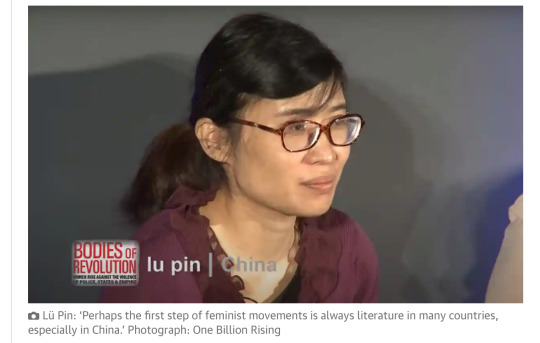
China’s feminist movement has grown enormously in the past few years, especially among young women online, says Lü, where it was stoked by the #MeToo movements around the world and given oxygen on social media. “But that’s just part of the story,” she says. Feminism is also facing much stricter censorship – the word “feminism” is among those censored online, as is China’s #MeToo hashtag, #WoYeShi.
“When we already have so many people joining our community, the government regards that as a threat to its rule,” Lü says. “So the question is: what is the future of the movement?”
Because large-scale organising is “almost impossible” in China, women are turning to “all kinds of alternative ways to maintain feminism in their daily lives and even develop and transfer feminism to others,” she says. These may take the form of book clubs or exercise meet-ups. Some of her friends in China organise hikes. “They say that we are feminists, we are hiking together, so when we are hiking we talk about feminism.
“Nobody can change the micro level.”
‘The first step’
In 2001, when Lü was a journalist starting out on her journey into feminism, she founded a book club with a group of friends. She was struggling to find books on the subject, so she and her friends pooled their resources. “We were feminists, journalists, scholars, so we decided let’s organise a group and read, talk, discuss monthly,” she says. They met in people’s homes, or the park, or their offices. It lasted eight years and the members are still among her best friends.
Before the book club, “I felt lonely when I was pursuing feminism. So I need friends, I need a community. And that was the first community I had.” “I got friendship, I deepened my understanding of feminism,” Lü says. “It’s interesting, perhaps the first step of feminist movements is always literature in many countries, especially in China.”
Lü first read Ueno’s academic work as a young scholar, when few people in China knew her name. Ueno’s books are for people who are starting out on their pursuit of feminism, Lü says, and the author is good at explaining feminist issues in ways that are easy to understand.
Like many Ting Guo discovered Ueno after the Tokyo University speech. Guo, an assistant professor in the department of cultural and religious studies at the Chinese University of Hong Kong, still uses it in lectures.
Ueno’s popularity is part of a larger phenomenon, Guo says. “We cannot really directly describe what we want to say, using the word that we want to use, because of the censorship, because of the larger atmosphere. So people need to try to borrow words, mirror that experience in other social situations, in other political situations, in other contexts, in order to precisely describe their own experience, their own feelings and their own thoughts.”
There are so many people who are new to the feminist movement, says Lü, “and they are all looking for resources, but due to censorship, it’s so hard for Chinese scholars, for Chinese feminists, to publish their work.”
Ueno “is a foreigner, that is one of her advantages, and she also comes from [an] east Asian context”, which means that the patriarchal system she describes is similar to China’s. Lü says the reason books by Chinese feminists aren’t on bestseller lists is because of censorship.
Na Zhong, a novelist who translated Sally Rooney’s novels into simplified Chinese, feels that Chinese feminism is, at least when it comes to literature, gaining momentum. The biggest sign of this, both despite and because of censorship, is “the sheer number of women writers that are being translated into Chinese” – among whom Ueno is the “biggest star”.
“Young women are discovering their voices, and I’m really happy for my generation,” she says. “We’re just getting started.”
By Helen R Sullivan
This is the third story in a three-part series on feminism and literature in China.
#China#Japan#Chizuko Ueno#Books for women#Feminism from Scratch#Patriarchy and Capitalism#Misogyny#Feminist Five#Lü Pin#WoYeShi
728 notes
·
View notes